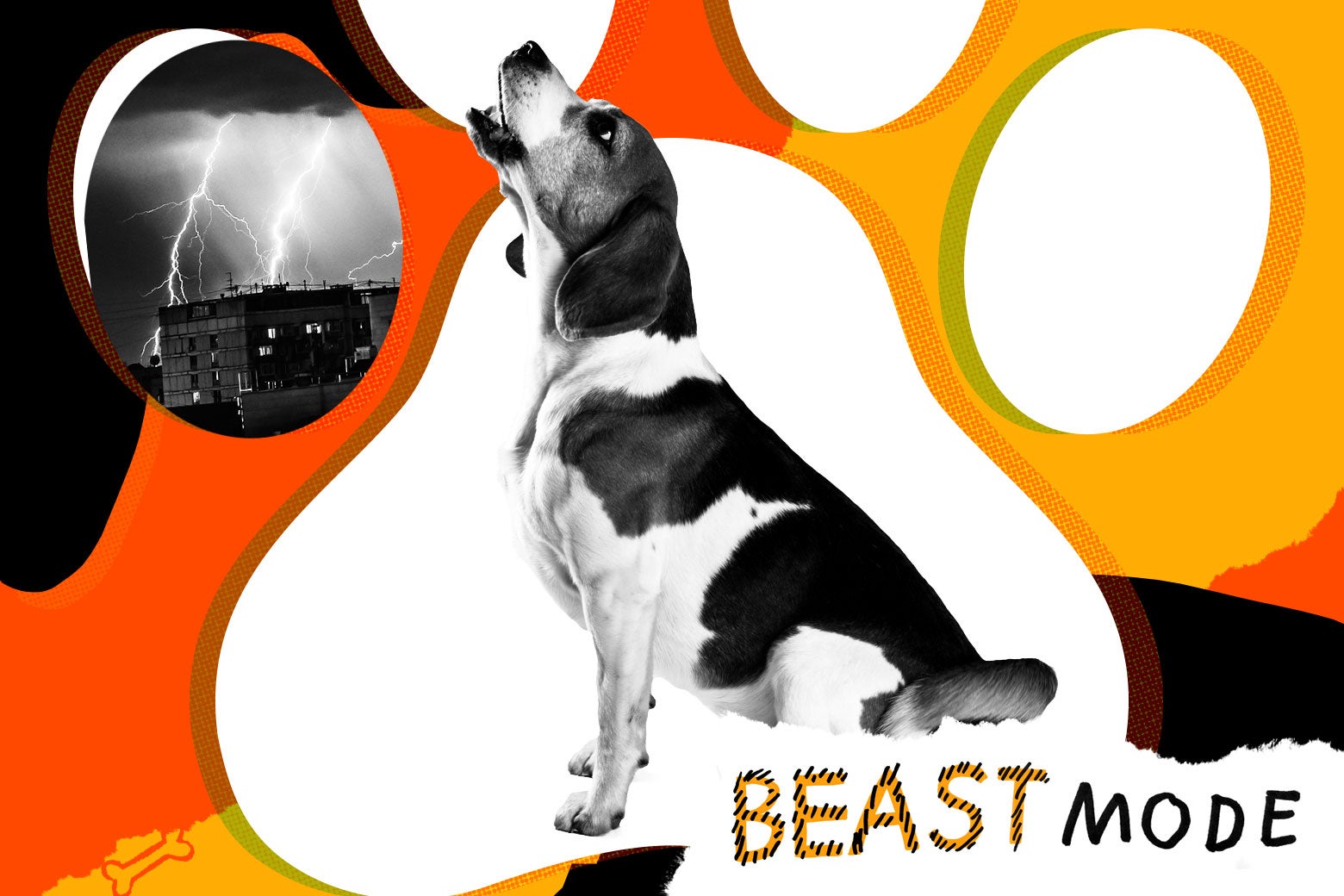Beast Mode is Slate’s pet advice column. Have a question? Send it to beastmode@slate.com.
Dear Beast Mode,
My dog goes crazy and barks during thunderstorms. He can bark for hours, and it seems like he’s always at it at 2 a.m. We’ve tried what seems like everything, including a thunder shirt and medication, but nothing works. Do we just ride it out and hope our neighbors forgive us?
—Bark and Stormy
Dear Bark and Stormy,
Where do you live that it always thunderstorms, on schedule, at 2 a.m.? Are you writing from a private detective’s office in a noir novel? Is your house the mansion from Clue? Perhaps your dog is barking mad because a climactic battle between the forces of good and evil breaks out whenever he tries to get some sleep.
“Nobody knows why some dogs develop thunderstorm phobia,” Nicholas Dodman, professor emeritus at Tufts University’s Cummings School of Veterinary Medicine and co-founder of the Center for Canine Behavior Studies, tells me over the phone. “It is quite common,” he says, and a survey that his organization conducted found that about 1 in 6 dogs experiences it.
Your pup has no way of knowing that he belongs to an elite club of worrying warriors, though his behavior might not be born out of a traditional phobia. “There are some dogs that are tough little dudes,” Dodman says. “This thing [a thunderstorm] comes along, and instead of them being shy and submissive, they’ll bark at it. Which of course doesn’t work.” Even if he’s trying to protect you from whatever giant happens to be stomping outside your window, he’s still experiencing anxiety, and your approach and treatment should be similar to what it would be toward a dog that is full-on terrified.
“You can try to desensitize them to the sound of thunderstorms,” Dodman says. There are albums designed for this purpose, in which mellow music is slowly merged with the noise of a traumatic stimuli. This progresses “until it’s like a full-blown storm with a concerto in the background,” Dodman says. “If you do it and go very gently, stepwise, it might work.” He adds that toys and treats should be administered throughout to make the mashup of Beethoven and rolling thunder palatable to your dog’s sensitive ears.
If your dog sleeps in your room or in a crate, he might feel constrained during storms, and this will only compound his anxiety. Does he have a go-to spot for when he’s nervous? Pick a room at the interior of the house that’s well insulated and set it up with a cozy bed and his favorite toys. It can become his safe zone—just make sure he can get to it freely during storms.
Calming music (sans thunder) may work as a distraction, and a white-noise machine can help attenuate the booms. In a previous column, I linked to a series of classical albums designed to calm anxious dogs. Queue up these tunes, and your pup will be able to wait out storms with the refinement and sophistication of a forlorn viscount peering out his estate’s rainy window.
Thunderstorms are tricky, because it’s not just the noise that stirs panic in dogs. Dogs can be attuned to changes in barometric pressure, and the increase in static electricity can also play a part in this all-you-can-fear sensory buffet. Dodman has found that dogs gravitate to places that are grounded—like bathtubs or behind sinks with pipes—which suggests that pups really may be responding to atmospheric charges. As such, some thunder shirts have sewn-in metal lining that works like Faraday cages to insulate dogs from static electricity. You can also rub a dryer sheet on your pup for a similar effect.
If your dog really is barking to keep the storm at bay, then you can approach the behavior as if the thunder were an enemy pooch encountered during a walk. Try a gentle leader, a device designed to treat leash aggression. Apply light pressure to the lead when he starts to bark and praise him when he stops. It’s probably not what you want to be doing at 2 a.m., but he’s already made sure you’re awake, so you might as well give it a shot.
Lastly, tell your vet that the prescribed medication didn’t work as desired. Some mood-stabilizing drugs take months to kick in, while others are situational. Keep your vet abreast of the situation and ask about alternative treatments like CBD, which has a calming effect on dogs.
No matter how you develop your plan of action, the most important thing is to be prepared. If you do live somewhere with punctual 2 a.m. storms, this should be easy. Set up your dog’s safe zone with whatever he needs and get him plenty of exercise during the day so he can burn off the energy that would be otherwise spent yelling at thunderclaps. It might seem like a lot of work for you, but that’s only fair. After all, you’re the one who made him live inside a Nathaniel Hawthorne story.
